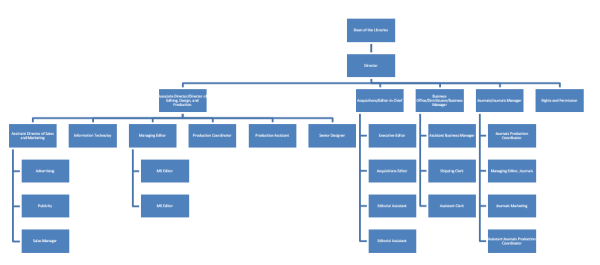- Executive Summary
- 1. Mission
- 2. Vision and Values
- 3. Significant Operational Milestones or Accomplishments, 203-2014 (in keeping with former strategic objectives)
- 4. Significant Acquisitions, Milestones or Accomplishments, 2013-2014
- 5. Notable Publications Awards
- 6. The Organization of the Press
- 7. Strategic Objectives for 2014-2017
- 8. Strategic Plan and Annual Report Exhibits
Founded in 1956, The Pennsylvania State University Press publishes annually fifty to sixty books and in 2014 thirty-three journals in print and/or digital form in the arts, humanities, and social sciences. The majority of books published are peer-reviewed scholarly monographs for research libraries. One or two titles appear annually in our Keystone Books® imprint, regional works for the citizens of Pennsylvania and the mid- Atlantic region. The Press operates on a modified cash accounting system and generates approximately $2.5 million in revenue to underwrite its operations. It receives a direct budget allocation of approximately 11 percent of its operating expenses to cover a portion of salary costs. It operates with a positive result. As a unit responsible for generating roughly 90 percent of its operating revenue, the Press must be creative, entrepreneurial, focused, and far-sighted. It must anticipate the future in a rapidly evolving industry and respond with vision, commitment, and resolve.
The Pennsylvania State University Press, reporting to the Dean of University Libraries and Scholarly Communications, publishes original scholarly, peer-reviewed research (books, journals, and other forms of research) in the arts, humanities, and social sciences for worldwide scholarly communities. The Press disseminates this research to international libraries, institutions, and scholars at affordable prices and at the highest quality. The Press also serves the citizens of Pennsylvania by publishing on topics related to the history, culture, literature, society, politics, and future of Pennsylvania and the mid-Atlantic region.
2.1 Vision
The Pennsylvania State University Press strives to establish its identity as an internationally recognized publisher of research in the arts, humanities, and social sciences, thereby advancing scholarship, enlarging our understanding of the world in which we live, and improving life for humankind. Publishing academic works of distinction enhances the reputation of the University and its faculty and staff, and it functions as a critical tool for connecting the University with the larger research community and the world. Publishing timely works of regional significance promotes the University to the citizens of Pennsylvania and contributes to the University’s overall mission in that regard.
2.2 Values
2.2.1. Education
We publish peer-reviewed, quality scholarship with an impact on research and education.
2.2.2. Dissemination
Through our publications we promote our University, our authors, and our mission worldwide.
2.2.3. Diversity
We publish books and journals that contribute to our understanding of the need for and nature of true diversity, our authors and journalcontributors come from more than seventy-five countries. Our publications have been translated into numerous languages, including Spanish, Italian, German, French, Polish, Slovenian, Romanian, Korean, and Portuguese. We have a diverse workplace, with first languages represented including Afrikaans and German, and the ability to translate Spanish, French, Dutch, and Italian.
2.2.4. Collaboration
We cooperate formally with numerous scholarly societies, associations, and educational institutions around the globe to publish first-rate original scholarship and scholarly translations. We offer noncommercial solutions to the publishing challenges facing academic societies, including the Eugene O’Neill Society, the American Society of Transportation and Logistics, the F. Scott Fitzgerald Society, and the Society for Values in Higher Education. University partnerships include Northern Illinois University and Penn State University, Nanjing University Press, Edinburgh University Press, Princeton’s Index of Christian Art, Yad Ben Zvi Institute in Jerusalem, the Frick Collection museum in New York and the Morgan Library in New York.
2.2.5. Quality
Our publications, whether book or journal, print or digital, mirror our commitment to material, scholarly, and customer-oriented quality.
2.2.6 External and Internal Commitments
We build relationships internally, with our colleagues across the University, as well as outside the University, with scholars, universities, and institutions worldwide—in Germany, England, Japan, South Africa, Israel, Australia, Korea, Turkey, Brazil, China, and other countries.
2.2.7. Integrity
We conduct our operation in a manner that is fair, environmentally friendly, economically balanced, honest, and respectful of others.
3. Significant Operational Milestones or Accomplishments, 203-2014 (in keeping with former strategic objectives)
3.1. Staffing
3.1.1.
Hired an additional journals production staff member.
3.2. Operations
3.2.1. Facilities
The Press continues to look for additional space.
3.2.2.
Press continues to investigate title management software.
3.2.3.
The first phase of achieving equity compensation for staff has been implemented. Phase 2 of 3 will be implemented in FY 2014–2015.
3.2.4.
Another planned redesigned website (www.psupress.org) is scheduled for 2014–2015.
3.2.5.
Exhibited at Frankfurt Book Fair for the third year. Contacts for translations continue to grow.
3.3 Journal and Book Production
3.3.1.
Added two journals for 2014 for a total of 33; 8 for 2015 (total 41) and 3 for 2016 (total 44).
3.3.2.
Continue to add titles to JSTOR and Muse’s ebook collections, with more than 300 ebook titles in aggregation across five platforms.
3.3.3
Ongoing investigation of XML workflow for books and EPUB file creation and have improved digital distribution dramatically via CoreSource.
3.4 Sales and Marketing
3.4.1.
Exhibited or attended annually 20 to 25 scholarly or industry events, including those for the American Historical Association, Pennsylvania Historical Association, International Congress on Medieval Studies, American Academy of Religion, College Art Association, and the National Communication Association, the Rhetoric Society of America, as well as the Charleston Library Conference and the Frankfurt Book Fair.
3.4.2.
Planned and executed successful monthly web sales, including a very successful online art history sale.
3.4.3.
Met sales budget goal.
3.5 Marketing the Press Itself
The Press has developed closer ties with its parent institution, including forging partnerships with Penn State Altoona (Interdisciplinary Literary Studies), Penn State Behrend (Edgar Allan Poe Studies), and Penn State University Park (Journal of Modern Periodical Studies; Critical Philosophy of Race; Comparative Literature Studies; Journal of General Education; Journal of Eastern Mediterranean Archaeology and Heritage Studies; Journal of Information Policy, Penn State Series in the History of the Book; Latin American Originals). Monograph series edited by Penn State faculty include Rhetoric and Democratic Deliberation, Refiguring Modernism, the Penn State College of Medicine, Graphic Medicine, and The Max Kade Institute for German- American Studies. The Press jointly sponsored a colloquium on general education in cooperation with the Senior Associate Dean of Undergraduate Education and the Faculty Senate. Press staff regularly participate in the Charleston Library Conference and in the Association of American University Presses. The Press director also traveled to Nanjing, China, where the Press established a collaboration with Nanjing University Press.
4.1. List Focus
The editor-in-chief is narrowing our list and focusing on the following subject areas: animal studies, art and architectural history; graphic medicine, early modern and medieval studies; American and cultural studies; rhetoric and communication studies, Jewish studies; American and European history; regional studies; religious studies.
4.2. Controlling Costs
Parameters for acquiring new volumes included limiting the number of illustrations (except for art and architectural history) and limiting the word count to 80,000 to 90,000 words. Some exceptions will be made, of course. The moratorium declared on edited volumes lacking subventions continues.
4.3. Noteworthy Grants
Awarded Mellon Art History Publishing Initiative grant to explore ways of moving art and art history onto digital and ebook platforms. The Press leads the initiative having released four titles published and having received $57,550 in grant money to date. The Press’s acquisitions department secured a $50,000 grant for the bird atlas project and a $45,000 subsidy for a work on mosaics in the ancient Mediterranean world.
5.1.
Leo Mazow, Thomas Hart Benton and the American Sound, was awarded the Smithsonian American Art Museum’s 2013 Charles C. Eldridge Prize for outstanding scholarship in the field of American art. (Announced, May 2013; presented September 2013.)
5.2.
Arabella Lyon, Deliberative Acts: Democracy, Rhetoric, and Rights, was awarded the 2014 Rhetoric Society of American book award.
5.3.
Angela Vanhaelen, The Wake of Iconoclasm: Painting the Church in the Dutch Republic was awarded the Sixteenth Century Society’s 2013 Roland H. Bainton Book Prize for art history. (Presented at the Sixteenth Century Society Conference, October 2013.)
5.4.
Cynthia Robinson, Imagining the Passion in a Multi-Cultural Castile was named one of four finalists for the College Art Association’s 2014 Charles Rufus Morey Book Award, which honors an especially distinguished book in the history of art. (Announced November 2013)
5.5.
Christian Kleinbub, Vision and the Visionary in Raphael won the Council of Graduate Schools’ 2013 Gustave O. Arlt Award in the Humanities (Presented December 2013)
5.6.
Areli Marina, The Italian Piazza Transformed. Parma in the Communal Age received the American Catholic Historical Association’s Howard H. Marraro prize given annually to the author of a book that is judged by a committee of experts to be the most distinguished work dealing with Italian history or Italo-American history published in the preceding year. (Presented at AHA, January 2014)
5.7.
Cynthia Robinson, Imagining the Passion in a Multi-Cultural Castile will be honored in two sessions sponsored by the Association for Spanish and Portuguese Historical Studies at the 2014 International Congress on Medieval Studies.
5.8.
Pamela A. Patton, Jews in Reconquest Spain won the American Society for Hispanic Art Historical Studies’ 2014 Eleanor Tufts Book Award.
The Press director reports to the Dean of University Libraries and Scholarly Communications (see Appendix 8.1). The University Libraries supports the Press in a variety of tangible and intangible ways. The Press currently has 28 FT employees. The press employs one part- time staff member. Half of one fixed term staff position positions (journals managing editor) is paid by the Provost and Dean of the Law Libraries (for two years); half of another FT position is paid by the College of Liberal Arts. The expected departmental breakdown of staff for FY 2014–2015 is as follows:
| Departments | Number of Staff | Employees |
|---|---|---|
| Book Production | 7.0 | JN, LRM, PM, JM, JS, SK, JG |
| Journals | 5.0 | DLP, JL, HS, AM, JK |
| Editorial Acquisitions | 5.0 | KB, EHG, KBY, HH, CR |
| Information Technology | 1.5 | ES |
| Sales/Marketing | 4.0 | TS, BB, KSJ, DB |
| Administrative | 2.0 | TC, SSS |
| Business/Warehouse | 4.0 | TL, KV, DB, CS |
| Total | 28.5 |
To meet the changing demands of the market and industry, the Press will continue to adapt its strategic plan over for the next three years. The Press will continue to emphasize (1) entrepreneurial strategies; (2) increased branding; (3) journals acquisitions; (4) acquisition of more broadly based scholarly works. This will not preclude the press from fulfilling its mission to publish “first books.” (5) A plan to reach out to various Pennsylvania-based institutions and organizations will be designed to increase the impact of the Press’s publications on the Commonwealth, open doors for more acquisitions of regional material, and broaden the market for our publications.
7.1. Operations/Administration
Top operational and administrative priorities include implementing a new title management system, refining the integration of the business office with day-to-day operations, and reexamining the work environment as it relates to staff productivity and job satisfaction. This will particularly involve securing adequate space for staff.
7.2. Acquisitions
The current principal market for the Press, libraries and other research institutions is rethinking its acquisitions and collection development priorities. Declining and flat budgets, shelving limitations, user demands, and an oversupply of print monographs have led libraries to reconsider their former purchasing strategies. A new movement toward Patron-Driven Access (PDA) is gaining momentum. Libraries see ebooks as a real opportunity to improve collections’ focus and usability, manage budgets, and deliver content in a format users want. The Press must reassess the financial models for existing ebook platforms (Muse, JSTOR ebooks, MyiLibrary, ebrary, NetLibrary, GooglePlay, and the like).
7.2.1.
Goal of increasing title-output by 10%-12%.
7.2.2.
Acquisitions will work to develop stronger connections with Library Development Office to find funding for key titles related to Pennsylvania, Penn State, or the region.
7.2.3.
Acquisitions intends to continue to develop our list with an eye toward academic strengths on campus and how we might synergize our profile with these strengths. Specific areas of focus include: communication studies and rhetoric, graphic studies, Latin American studies, animal studies, art and architectural history, literary studies, medieval and early modern studies, Pennsylvania and mid-Atlantic history, religious studies, and book history.
7.3. Journals
The Press expects to continue to grow its journals program to serve the wider scholarly community, library communities, and universities in general by becoming a source of publishing services for societies, associations, and other journals that might otherwise fall into the hands of commercial publishers. Journals also provide a stabilizing source of income via subscriptions, allow for quicker dissemination of scholarly content, and have the greatest potential for reaching a worldwide audience. Increasingly, scholars will be looking to journals as publishing options as monograph publishing opportunities decrease.
7.3.1.
Continue to add journals.
7.3.2.
Continue to emphasize international impact of our journals.
7.4. Sales and Marketing
As the percentage of sales to libraries decrease the press must position itself to publish not only scholarly monographs but also books for a wider readership.
7.4.1.
Redefining the list and its market are twin tactical steps for 2014–2017.
7.4.2.
We’ll look to better brand the press statewide and to the larger academic audience.
7.4.3.
We’ll slowly incorporate more buyer visits to trade wholesalers, increase communication with vendors, buyers, and wholesalers like Ingram, YBP, B&T, Coutts, B&N, and Midwest.
7.4.4.
Working with Amazon will remain a significant challenge. Sales and marketing would like to find alternatives to that sales channel, and more direct to consumer sales would be welcomed.
7.5. Production, Design, Editorial
We will strive to continue to adapt to the changing nature of scholarly publishing. This includes streamlining as much as possible the time-to-publication, implementing new workflows to optimize digital delivery and stay abreast of digital technology, and assess protocols for digital archiving. We must simultaneously maintain the highest quality in design and production standards while watching our costs carefully. Ongoing use of a track system and other savings strategies continue; we’ll look to introduce a second series of tracks related to a volume’s potential in the market. In cooperation with the Libraries, the Press is digitizing roughly 200 backlist titles. These will be made available to the Penn State community in an Open Access environment. The Press will monetize backlist ebooks outside the campus. Editorial/Design/Production will continue to look for ways to reduce the carbon footprint of the Press.
7.6. Business Office
Strategic steps in the business office include integrating the distribution and fulfillment operation with the rest of the Press, particularly sales and marketing (sales, returns, etc.), production (costs), journals (costs and revenue), and acquisitions. Improving reporting for sales and marketing will be key in the Press’s new strategic initiative to reach a wider audience. Refining accounting practices in and around journals will also be a strategic priority.
7.7. Information Technology
Facilitate and oversee implementation of InOrder and a title management system (to be selected), ensuring that the Press’s best interests are maintained. Gather feedback from department staff during development and implementation so that functionality is optimal and costly changes won’t be required. Continuing to provide day-to-day operational support to the entire staff at the network and workstation level, providing both hardware and software support.
7.8. Press-Libraries Collaboration
The Press and Libraries will continue to work collaboratively on Metalmark Book series, on special collections related projects (e.g., the utopian studies bibliography project), on a backlist digitization project, with volumes being made Open Access to all PSU campuses. Press will invite a technologist from the Libraries to serve on advisory board for a three-year Mellon-initiative proposal currently under consideration by Mellon. Press and Libraries are also exploring a Library constructed website for hosting interviews, audio and visual files related to the Press’s two-volume work, Nothing But Love in God’s Water, a history of black sacred music and the civil rights movement.
8.1. Appendix 1: Organizational Chart: The Pennsylvania State University Press
- Dean of the Libraries
- Director
- Associate Director/Director of Editing, Design, and Production
- Assistant Director of Sales and Marketing
- Advertising
- Publicity
- Sales Manager
- Information Technoloy
- Managing Editor
- MS Editor
- MS Editor
- Production Coordinator
- Production Assistant
- Senior Designer
- Assistant Director of Sales and Marketing
- Acquisitions/Editor-in-Chief
- Executive Editor
- Acquisitions Editor
- Editorial Assistant
- Editorial Assistant
- Business Office/Distribution/Business Manager
- Assistant Business Manager
- Shipping Clerk
- Assistant Clerk
- Journals/Journals Manager
- Journals Production Coordinator
- Managing Editor, Journals
- Journals Marketing
- Assistant Journals Production Coordinator
- Rights and Permissions
- Associate Director/Director of Editing, Design, and Production
- Director
8.2. Appendix 2: Financial Snapshots of the Press
8.2.1 Expense by Source, FY 2013-2014
| Source | Amount | Percent of Operating Expenses |
|---|---|---|
| Acquisitions | $52,168 | 2% |
| Book Fulfillment | $25,800 | 1% |
| Computer Support | $8,658 | less than 0.5% |
| Administration | $94,726 | 3% |
| ODSP | $1,417 | less than 0.5% |
| Salaries/Wages | $1,407,033 | 46% |
| Book Manufacturing/Production | $719,921 | 23% |
| Journal Expenses | $504,017 | 16% |
| Royalties | $77,798 | 3% |
| Marketing | $182,138 | 6% |
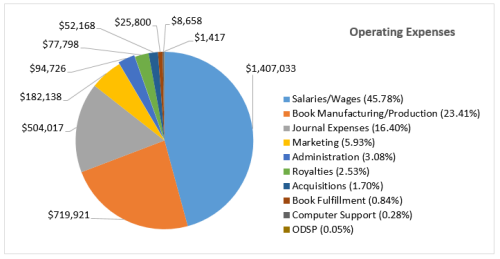
Penn State Press Operating Expenses by Source Fiscal Year Ending June 30, 2014
| Source | Amount | Percent of Operating Expenses |
|---|---|---|
| Grants/Awards | $94,707 | 3% |
| Book Income | $1,425,595 | 49% |
| Journal Income | $1,002,027 | 35% |
| Rights and Permissions | $38,530 | 1% |
| University Allocation | $354,219 | 12% |
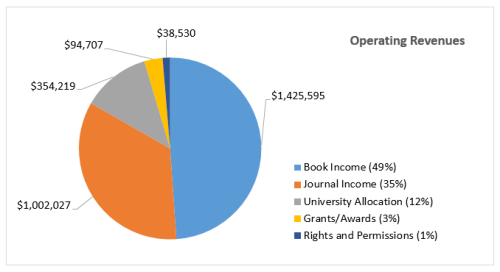
Penn State Press Operating Revenues by Source Fiscal Year Ending June 30, 2014
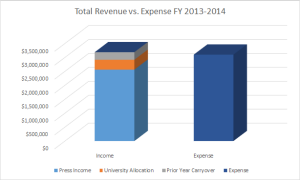
| Source | Amount |
|---|---|
| Press Income | $2,560,859 |
| University Allocation | $354,219 |
| Prior Year Carryover | $272,145 |
| Press Expenses | $3,073,676 |
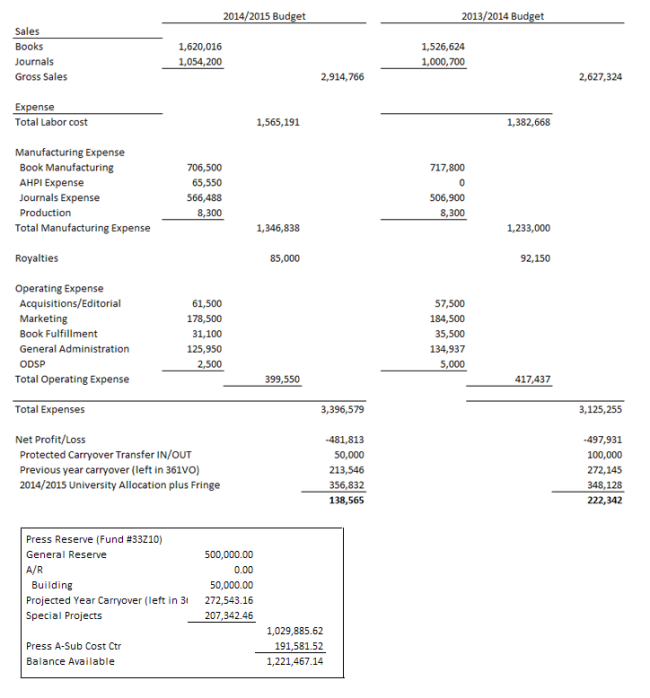
8.3. Appendix 3: Press Fact Sheet
Summary. Founded in 1956, The Pennsylvania State University Press publishes annually fifty-sixty books and (in 2014) thirty-three journals (in print and digital form). Hundreds of front- and backlist books are available as ebooks across a range of platforms (Kindle, GooglePlay, Nook, ebrary, NetLibrary, Muse, JSTOR). The majority of books published are peer-reviewed scholarly monographs for research libraries. One to three titles appear annually in its Keystone Books® imprint, whose titles, though reviewed, are regional works for the citizens of Pennsylvania and the mid-Atlantic region. The Press has its own warehouse and distribution facility and distributes for entities other than the Press. The Press operates on a modified cash accounting system and generates approximately $2.5 million in revenue to underwrite its operations. The Press reports to the Dean of Libraries and Scholarly Communications.
Mission and Values. The Press publishes original scholarly, peer-reviewed, award-winning research (books, ebooks, journals, and other forms of research) in the arts, humanities, and social sciences for worldwide scholarly communities. The Press disseminates this research to international libraries, institutions, and scholars at affordable prices and at the highest quality. The Press also serves the citizens of Pennsylvania by publishing on topics related to the history, culture, literature, society, politics, and future of Pennsylvania and the mid-Atlantic region. Chief values for the Press both within and outside the University include: a national and international commitment to education, dissemination and access, diversity, collaboration, quality, and integrity.
Finances. The Press, a not-for-profit entity that operates on a modified cash accounting system, anticipates FY 2014– 2015 budgeted income totaling $2.9M: from books ($1.25M), journals ($1M), and rights, permissions and external grant/subsidy income ($250K) to underwrite its operations. This is a projected increase of 9.8% over FY 2013–2014. It receives a direct budget allocation of approximately 10.9% of its operating income ($348K) to cover its budgeted operating expenses of ~$3M. Because of financial carryovers from preceding years and accounts receivables, it operates with a small positive result. It carries a cash reserve of $500K, maintains a subsidy encumbrance account of roughly $190K, and has set aside $205K for special projects, such as upgrading backoffice software systems and investing in technology. The Press has also set aside $50K for facilities improvements. Thus the balance available to the Press is slightly over $1M. Salaries (for 28 FT staff) account for roughly 46% of the Press’s operating budget, manufacturing costs for books and journals makes up 36%; royalty payments account for 3%; and operational costs run around 14%.
Investment in a vigorous journals publishing program (the ninth largest in quantity among university presses) and an anticipated investment in backlist digitization for ebooks are expected to result in even stronger financial results in 2014–2017.
Essential strategic priorities for 2014–2017
- implement presswide title management system;
- find/acquire additional space;
- increase sales potential of projects acquired;
- continue to strengthen and expand journals program;
- increase international presence of the Press;
- strengthen Press branding.
PDF version of the 2014-UL-Strategic-Plan.pdf
